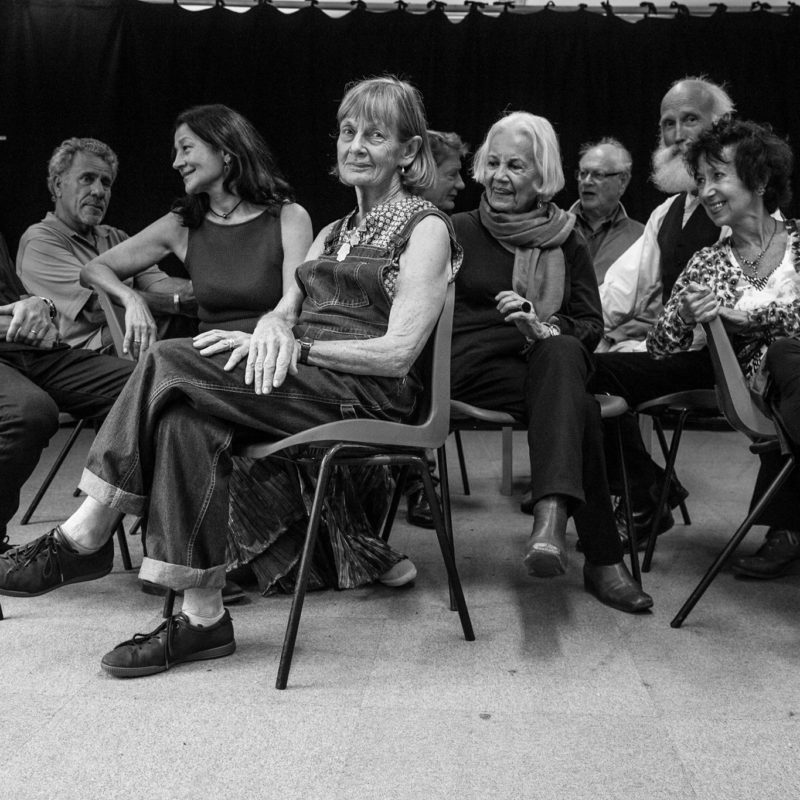Practice as research
/praktɪs az rɪˈsəːtʃ/
PaR / acronym
verb
• A dynamic form of research to find, create, uncover, acquire and disseminate knowledge.
• A methodology for meshing creativity and experimentation in live performance practice. The practice becomes the crucible for creating and challenging knowledge.
Source
Sally Mackey (2016) “Applied theatre and practice as research: polyphonic conversations”, Research in Drama Education: The Journal of Applied Theatre and Performance, 21:4, 478-491.
Origin
Applied drama practice, theatre in education
PaR enquiry
The cultural pressures on older women to stay slim and youthful-looking if they are still to be deemed worthy of interest is nowhere more pervasive than in the acting profession. The prevalent cultural bias towards youth discriminates more against older female actors than older males, who continue to play leading and even romantic roles, their lined wrinkled faces re-defined as ‘craggy’, or ‘lived-in’ rather than ‘wrinkled’. This bias combined with the paucity of roles for older women means that older women actors find their careers dropping off even more than their male counterparts. For some, taking control by producing their own work, often in the form of auto/biographical one-woman shows, can reap huge rewards of empowerment and creativity. At the time of this research (2016), there were no training opportunities tailored for older women actors that fulfil this need.
Research questions
- How do we create performance outlets with and for professional female actors that also act as training grounds for new skills, particularly those that are entrepreneurial?
- What themes are relevant for this cohort of women to build on for such performance work?
- How do we improve auto/biographical or documentary theatre making practices when thinking about ethical representation from real-life?
Background
This enquiry emerged from RQ1: How do we create workshops that will both invigorate and harness the skills of older actors? which, as part of its evaluation, concluded that training opportunities are needed for older actors but perhaps they would have more value if they included performance-making processes and a performance outcome.
We believe professional older actors have a vast store of life experience and talents that is often under-used. This research inquiry sought to harness this unique store in a project concerned with capacity building for older female actors as well as visibility and identity in older age.
Project aims
This cohort of women – the baby boomer generation – have been both platformed and marginalised on the basis of their appearance, often mediated by their choice of clothing. The Wardrobe Project therefore sought to achieve the following:
- to create a safe space for a group of older female actors to share their feelings about ageing through the medium of clothing – a kind of consciousness raising.
- to unveil and strengthen the skills, experience and resources of older female actors by training them to be researchers and co-creators of a new documentary theatre work on clothing, the body, and age, to be performed in theatre and non-theatre spaces
The project offered a space to the actors to explore their shifting identities over time, as reflected by their evolving clothing choices and by their changing body. This as a precursor to collecting similar stories from older women in the community about how they have expressed their identity over different periods of their lives via clothing.
Dates
The Wardrobe Project took place over 6 weeks from the beginning of April to mid-May 2016, culminating in a showing at Graeae Studios, Hoxton.
Venue
We worked from the Fireroom and Courtroom at Toynbee Studios, Aldgate for the initial training stages, eventually moving to Graeae’s Bradbury Studios for the final two weeks development and rehearsal.
Overview of the process and photos are in the two right columns >>
Evaluation
- all participants were extremely positive in how the process was structured, with most commenting anecdotally and in writing about how it increased their knowledge as theatre-makers
- all women gained a lot personally as well as professionally from it being a women-only project, suggesting that it created a safe space for both learning and sharing
- all women were interested in working further like this in the future, and in a second stage of the project’s development
Photos © ViSiBLE and Nadia Otshudi
Audience feedback






The Wardrobe Project overview
The Wardrobe Project is the first in Visible’s experimentation with more meaningful theatre-making frameworks for professional actors, the women undergoing cutting-edge research and training as a precursor to interviewing a spectrum of women in their 60s and 70s with a diverese range of attitudes to clothing and their ‘older’ age.
Actors (from left to right) Di Sherlock, Shenagh Govan, Yvonne Gidden, Denise Stephenson, Sue Kelvin, Norma Cohen, Gilian Cally and Ruth Posner worked in concert with Director Rachel Grunwald and Playwright Sonja Linden to prepare for their interviews of women in the community and collaboratively develop this new piece of theatre.

The project opened with an intensive research stage, led by Professor Julia Twigg of the University of Kent, on her work at the intersections ageing and sociology, particularly on the body, clothing and age. It also included research on documentary and verbatim theatre, and the ethics of representation, led by Claire French and Sonja Linden collectively. The actors were also trained in interview approaches and techniques by former BBC producer Chris Mohr, before they entered fieldwork as the interviewers.
After the interviews, the actors returned to collate their findings with writer Sonja Linden, who created a performance script from transcriptions of their interviews. This research and development phase was followed by a two week script development period, culminating in a showing at Graeae Studios.
You Might also like
-
Dream (ViSiBLE Shorts 001)











